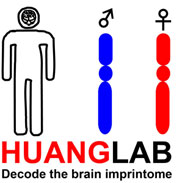News and Events
Lin CY, et al. (2018) Allele-specific expression in a family quartet with autism reveals mono-to-biallelic switch and novel tranZional processes of autism susceptibility genes. Scientific Reports. 8:4277
Abstract
Autism spectrum disorder (ASD) is a highly prevalent neurodevelopmental disorder, and the exact causal mechanism is unknown. Dysregulated allele-specific expression (ASE) has been identified in persons with ASD; however, a comprehensive analysis of ASE has not been conducted in a family quartet with ASD. To fill this gap, we analyzed ASE using genomic DNA from parent and offspring and RNA from offspring’s postmortem prefrontal cortex (PFC); one of the two offspring had been diagnosed with ASD. DNA- and RNA-sequencing revealed distinct ASE patterns from the PFC of both offspring. However, only the PFC of the offspring with ASD exhibited a mono-to-biallelic switch for LRP2BP and ZNF407. We also identified a novel site of RNA-editing in KMT2C in addition to new monoallelically-expressed genes and miRNAs. Our results demonstrate the prevalence of ASE in human PFC and ASE abnormalities in the PFC of a person with ASD. Taken together, these findings may provide mechanistic insights into the pathogenesis of ASD.
Link (https://www.nature.com/articles/s41598-018-22753-4)
Autism spectrum disorder (ASD) is a highly prevalent neurodevelopmental disorder, and the exact causal mechanism is unknown. Dysregulated allele-specific expression (ASE) has been identified in persons with ASD; however, a comprehensive analysis of ASE has not been conducted in a family quartet with ASD. To fill this gap, we analyzed ASE using genomic DNA from parent and offspring and RNA from offspring’s postmortem prefrontal cortex (PFC); one of the two offspring had been diagnosed with ASD. DNA- and RNA-sequencing revealed distinct ASE patterns from the PFC of both offspring. However, only the PFC of the offspring with ASD exhibited a mono-to-biallelic switch for LRP2BP and ZNF407. We also identified a novel site of RNA-editing in KMT2C in addition to new monoallelically-expressed genes and miRNAs. Our results demonstrate the prevalence of ASE in human PFC and ASE abnormalities in the PFC of a person with ASD. Taken together, these findings may provide mechanistic insights into the pathogenesis of ASD.
Link (https://www.nature.com/articles/s41598-018-22753-4)



